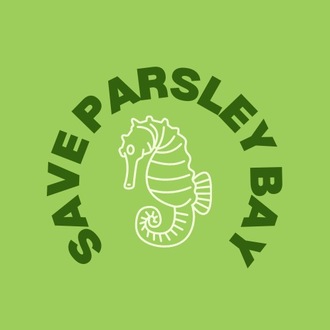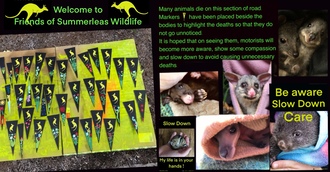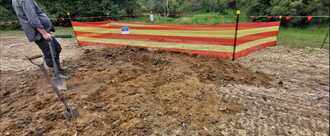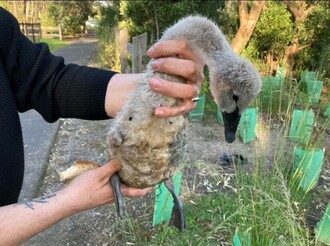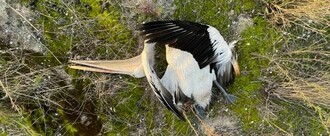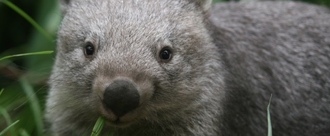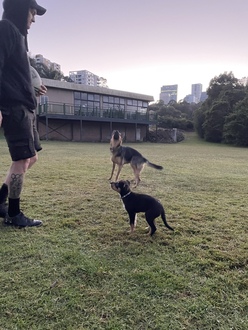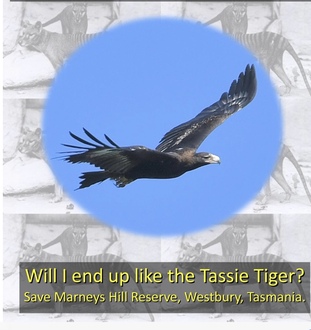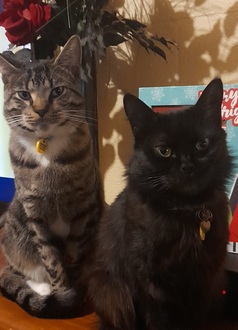-
Save Parsley Bay - *SEE NEW PETITION LINK BELOW**NEW PETITION LINK* - https://www.parliament.nsw.gov.au/la/Pages/ePetition-details.aspx?q=vJ6XNj1QnevTFY9U2SI2bA Parsley Bay is a natural phenomena (backed by experts). There is an anomalously abundant amount of marine, animal, and plant life within this Littoral Rainforest. With a minimum of 3 years of construction (and likely complications), this PARTIALLY underground project will uproot partial (yet significant) amounts of the rainforest area of the Reserve. This includes the removal of trees, significant drilling and digging, and highly likely contamination of the soil, creek and harbour. Parsley Bay reserve is home to a Plethora of endangered Flora, Fauna and Marine Life. This project poses a massive danger to these vulnerable species, and the risk of extinction cannot be ignored! The White Seahorse and the Powerful Owl are just two of many beautiful, at-risk species who call Parsley Bay home. We can't jeopardise their existence or the significant role that they play in our ecosystem! Regardless of where you live, you can help us to save the natural inhabitants of this little pocket of paradise. Don’t let Sydney Water take advantage of the people, let’s take action to save our environment! @saveparsleybay - on all platforms5,183 of 6,000 SignaturesCreated by Max Miller
-
Make Summerleas road safer for all, people and wildlife.We are concerned for the safety of all road users including pedestrians, cyclists, dog walkers, horse riders and wildlife that traverse the road. Speeding drivers ignore speed limits and fail to drive to the conditions killing wildlife at night and increase the risk of accident and injury to people in the day time. Wildlife deaths occur almost every night in this well known black spot. The average for the whole of Tasmania is one wildlife death per 3 kilometres. At certain times of the year this section of Summerleas road has recorded an average of one death per 8.5 metres. A total of 65 wild lives were lost on this section of road between the 4/9/21 and the date of this petition. This figure does not include at least 9 known joeys that also died along with their mothers and 3 injured animals that had to be rescued and euthanised due to the severity of their injuries. The Natural Values Atlas lists 3 threatened mammal species of concern for this area. They are the Eastern barred bandicoot, Eastern quoll and the Tasmanian devil. Several Bandicoots have been killed recently on the road. Eastern quolls and Tasmanian devils have been sighted (and devils accidentally trapped) by residents on properties close to the road. The phycological effect on the community that witnesses this amount of death on such a short section of road must not be overlooked. The danger to human life of injury and death is just as real and also needs to be addressed. There is a concentrated population of horse riders in this area, and close surrounding areas and a long established horse agistment centre actually within the section of road that is our major concern. To reach the few safe and designated riding trails that exist, riders must ride through this section as they have no alternative choice. There have been many incidents of very near misses involving horses, their riders and inconsiderate and speeding drivers. There are no safe pathways or verges. The road has at least one dangerous blind corner and is quite narrow in places with nowhere to safely get off the road. The shoulders are narrow with significant ditches and areas where the ground drops away steeply while other sections have a high embankment. These conditions make it dangerous for horse riders, cyclists, dog walkers and pedestrians in general. Many school children regularly walk to and from school bus pick up, and drop off points. The community includes cycling enthusiasts and people who regularly walk their dogs. Both groups also report incidences where an accident has only been averted by sheer luck, including a dog (on lead) that was lucky to escape with severe bruising after an accident involving a speeding driver. The road is undoubtedly a shared zone and drivers need to be alerted to that fact and encouraged to drive appropriately. Signage alerting drivers to the wildlife death black spot need to be installed and a reduced dusk to dawn speed limit imposed. It has been well studied and documented that a reduction of speed between dusk and dawn would reduce the wildlife deaths on Tasmanian roads by a huge amount. (Hobday 2010 ) Some estimates suggest as many as half the estimated annual 500,000 animals could be saved by reduced speed between dusk and dawn. Other mitigation initiatives should also be explored such as speed humps and new generation virtual fences designed for Tasmanian conditions and wildlife. Other options could include community based and created art works that highlight the issues and engage the public in creative and new ways. The people who have signed this petition request Kingborough Council implement speed restrictions, signage and safety measures to make this particular road a safer place for everyone, people and animals.379 of 400 SignaturesCreated by Ruth Waterhouse
-
Save Moreland's magnificent River Red GumsEvery single tree assessed as highly significant in December 2021 by government-appointed arborists has been destroyed to make way for a giant car park at Merlynston, just 10km north of the city. These are now the only significant indigenous trees that remain standing within cooee of Merlynston Station on the Upfield Line after the Victorian Government appointed its Level Crossing Removal Project to double the size of the car park. The government is using the special powers of the LXRP to steamroll the local community and council's wishes to keep these trees. The community consultation report for the Merlynston Car Park project, obtained by residents through Freedom of Information, showed that retaining existing trees was their top priority and cited in 53 per cent of submissions to the LXRP. This unwanted car park expansion has been jointly funded by the former Scott Morrison government. In December, arborists prepared a report for the Victorian Government describing these two stunning, large trees east of Merlynston Station as highly significant and said the car park project should take all available measures to protect their roots. This was the plan, until recently. On May 31st, four months after the car park project began, the Victorian Government suddenly letterboxed residents of Bain Avenue and told them the street's two River Red Gums would be coming down within weeks . Enough is enough! Enough sham consultation with community! Enough destruction of Moreland’s significant canopy and habitat trees! Enough new car parks! Listen to us! Change your plan and spare these valuable trees!658 of 800 SignaturesCreated by Merlynston Community 3058
-
Stop the further destruction of the off leash dog park in Lawson Blue Mountains NSWThe park is not only enjoyed by dogs and their owners but families and children, on bikes, walking who enjoy a natural ramble through the trees... not concrete paths. The local Blue Mountains community are not happy with what has been destroyed... including a turtles nest and other habitat.60 of 100 SignaturesCreated by Jude Warren
-
Save Peter Hopper Lake and our wildlifeOur wildlife are dying because the Lake is diseased, and the water is toxic. The lake has been fenced off for 20 months, Council have done nothing. 22 baby signets have died over this time, dead birds surround the lake, resident turtles are coming onto land, dead carp are floating in the water. Another signet died last week, and my daughter has just received a call about another one dying. It's sad, and it's wrong. We need to let the Council know we need to get this fixed. please sign our petition and share with your friends - the more the better.9 of 100 SignaturesCreated by Margaret Gascoyne
-
Save Canning Vale KangaroosWhy are these kangaroos a problem? Aren’t they simply living their lives with their families in their home range? Yes. However, the City of Canning wants to construct a new road and a sports complex in the kangaroos’ home range. A new road, the Jandakot Eastern Link, will improve traffic flow to the airport. The road will dissect kangaroo habitat, leading to fears the kangaroos will cause vehicle accidents. Bushland will be cleared to build a new sports facility. The new road and sports facility will destroy much of the kangaroo habitat, leaving only 22-hectares of fragmented land for the kangaroo population. Habitat loss is a major problem for kangaroos. In 2007, 38% of Western Australia was used for agriculture. Urbanisation and agriculture are constantly expanding. The new Jandakot Eastern Link is yet another example of humans destroying habitat and forcing kangaroos into tiny, fragmented areas. The City of Canning is yet to seek a permit to cull and, right now, there isn’t a culling order in place. The City is engaging with the surrounding land owners as it plans the management of the kangaroo population. There is fear from the public that the kangaroos will be denied access to water. Australian Governments consider fencing to deny kangaroos access to water as a viable way of reducing kangaroo populations. This “management method” is cruel and shouldn’t be promoted by Government. Indeed, this inhumane method of kangaroo control should be illegal. We, the undersigned, implore the City to ensure the safety of the kangaroos. The immediate concern is that the kangaroos have access to food and water. Often during construction, kangaroos become restricted by fencing and unable to access water. We request guarantees from the City that the kangaroos will not be harmed by a lack of food or water. Furthermore, the undersigned implore the City to work with wildlife carers, to utilise the expertise and knowledge of wildlife carers accustomed to working with kangaroos. Many wildlife carers have offered to volunteer their services to ensure the safety of the Canning Vale kangaroos. We ask that the City contact us to provide names of wildlife carers willing to assist the City. Finally, the undersigned, implore the City to investigate the construction of wildlife underpasses or overpasses. Wildlife under-or-overpasses are achieving great results around the world. We implore the City to be a leader in creating safe passage for Australian wildlife. “You can get reductions of 85 to 95 percent with crossings and fencing that guide animals under or over highways,” said Rob Ament, the road ecology program manager at the Western Transportation Institute at Montana State University, to National Geographic’s Starre Vartan in 2019. Western Australia has constructed numerous successful fauna bridges. Wildlife was photographed using the bridges. Working with wildlife carers and building fauna bridges is the future for a great state like Western Australia. (For more information: https://annualreports.mainroads.wa.gov.au/AR-2019/overview/our-stories/animal-welfare-a-priority-with-our-first-fauna-bridge.html https://www.96fm.com.au/local/check-out-this-local-wildlife-using-perths-new-fauna-bridge) Australia needs to learn to co-exist with our beautiful, unique wildlife. The Jandakot Eastern Link is a chance for city officials to work with wildlife carers and, at the very least, to create over-or-under passes to ensure safe passage for wildlife and humans. The time has come for co-existence, not execution.874 of 1,000 SignaturesCreated by Friends of Mother Earth
-
Install powerline markers in protected bird flight pathsYet another precious life prematurely taken and found underneath high voltage powerlines in the middle of a sanctuary. Australian Pelicans along with other large bird species that hit powerlines suffer greatly in their final moments from broken wings as a consequence of hitting these power lines during flight. AMWRRO has documented secondary breaks to beaks and legs, as a consequence of hitting the ground at speed and from such a great height. These accidents often occur in isolated/inaccessible areas making observations of these incidents rare and any response time delayed if at all. AMWRRO has over the years requested for these lines to be marked via “flexible reflective discs” or “powerline marker balls” that will help birds identify these hazards in known flight paths and over sensitive areas such as sanctuaries. Unfortunately our requests to date have fallen of deaf ears and thousands of birds have been killed prematurely! You may ask yourself why haven't these been installed sooner? - cost and effort to maintain such devices; its a simple as that. Please sign this petition to help save thousands of lives that have ended prematurely, unnecessarily and in an enormous amount of pain and suffering.77 of 100 SignaturesCreated by Australian Marine Wildlife Research and Rescue Organisation

-
Stop the Destruction of Wildlife Habitat in Mittagong!To make way for the cabins, 4.2 hectares will be cleared and 249 trees will be cut down. Wombats are to be removed from the area and fenced out. Two new access roads, sufficient to carry fully-loaded fire trucks with 4 metres cleared on each side, are to be built. A new bridge strong enough to support the weight of loaded fire trucks will be constructed over water inhabited by platypus. Help us save this precious habitat corridor for Frensham's future students and the Southern Highlands community.3,023 of 4,000 SignaturesCreated by Gaye White

-
Waverton Dog Park Night LightsThis dog park is used by many people and canines every afternoon, most of whom all know each other and are good friends with each other and come down together for the enjoyment of socialisation with each other and exercise. This is even more precious to some during the current pandemic as its the only face to face contact they get all day. However due to the winter sun and day light savings by the time we get down there its pitch black which presents alot of safety issues for ourselves, passers by, cars and of course the pooches. Its safe to say the park is used by many at this time of night. The difference in the amount of dog owners that are down in summer arvos and winter arvos is very noticeable. Many people arent willing to risk it or deal with the anxiety of not being able to see the dogs and as such forfeit the experience which is harmful to the human and pooches socialisation and exercise. Also anyone walking through to balls head or to the lower park for sport cant see whats going on which can be scary and dangerous.58 of 100 SignaturesCreated by Alastair Noble
-
Confine Domestic Cats in New South WalesCurrently in New South Wales, your neighbor's cat can come onto your property and even into your house at any time of the day or night; defecate in your flower garden, vegetable patch or child’s sand box; spray your plants and walls, and scare and kill the native wildlife in your garden. To an ordinary person, any cat doing any of these things would be deemed a “nuisance.” But NSW has a much narrower legal definition of a nuisance cat. NSW law considers a cat a “nuisance” only if it “makes a noise that persistently occurs or continues to such a degree or extent that it unreasonably interferes with the peace, comfort or convenience of any person in any other premises, or “repeatedly damages anything outside the property on which it is ordinarily kept” (Companion Animals Act 1998, Sec. 31) (emphasis added). The burden of proof is on you. Only if you can prove one of these highly subjective offences, can your local council make a “nuisance cat” declaration and act. But it is highly unlikely an ordinary citizen could prove either of these two definitions of a nuisance cat to a court’s satisfaction. In all cases, the offences would be fleeting and/or occur at night. Complainants would have to have audio or photographic evidence. Audio evidence, most likely available only at night, would have to be certified as to time and place, and be precise as to identify the cat. Photographic evidence would have to be unequivocal as to location (the complainant’s property). These problems make it almost impossible to provide the evidence necessary to meet the current definition of a nuisance cat. “Prove it was my cat!” “Prove it was on your property!” In effect, therefore, offended owners have no practical recourse to stop a cat coming onto their property and doing whatever it likes. The current law is ineffective, and ineffective law is bad law. There are two reasons why there is no effective control of roaming cats. First, it is thought to be cruel or “unnatural.” Second, it is an unreasonable inconvenience to cat owners. As to cruelty, the RSPCA recommends that Australia move to 24 hour-containment of domestic cats (https://kb.rspca.org.au/wp-content/uploads/2019/01/Identifying-Best-Practice-Domestic-Cat-Management-in-Australia-RSPCA-Research-Report-May-2018.pdf). Further, when a well-fed domestic cat kills wildlife, arguably, its owner perpetrates a preventable and unnecessary act of animal cruelty through the agency of their cat. Research suggests that pet cats in Australia kill up to 230 million native animals per year. As to confinement being an inconvenience to a cat’s owner, this is no greater than the frustration and anger at the loss of amenity for the neighbouring householders who like their gardens and love their wildlife and are told they just have to “live with it.” And one cat can impact many properties. Radio-tracking shows that domestic cats routinely roam across three or four neighbouring yards, with occasional forays two or three times this distance and into adjacent bushland. Twenty-seven percent of Australia households have cats, and 14 percent of households let their cats roam. Why should the 86 percent of non-cat and responsible-cat households have to pander to this “don’t-care” minority? There are three ways cats can be kept from roaming: keep them indoors; put them on a tether when outdoors, or keep them in a cat run. All these restraints are sanctioned by animal welfare legislation, and responsible owners already use them. Indeed, many cats are kept indoors their entire lives. No other domestic animal is allowed to roam freely through our neighborhoods, so why should domestic cats?8,406 of 9,000 SignaturesCreated by Allen Greer
-
Save Marney’s Hill Wildlife Nature ReserveThe reserve is valuable habitat for flora and fauna, including endangered species such as Masked Owl (only 350 breeding pairs left); Wedge-Tailed Eagle (less than 900 remain in Tassie); Tassie Devils (85% losses); Green and Gold Frog (20% drop in numbers; many other native birds; Echidna; Bandicoots; and Wombats (soft release). Destroying this habitat to build a prison, when there are alternative prison sites with low natural values should be unconscionable.16 of 100 SignaturesCreated by Peter Mackenzie
-
Affordable Animal Desexing for FootscrayTo able people to afford to desex there animals at an affordable price..7 of 100 SignaturesCreated by Caylee Maniatopoulos

